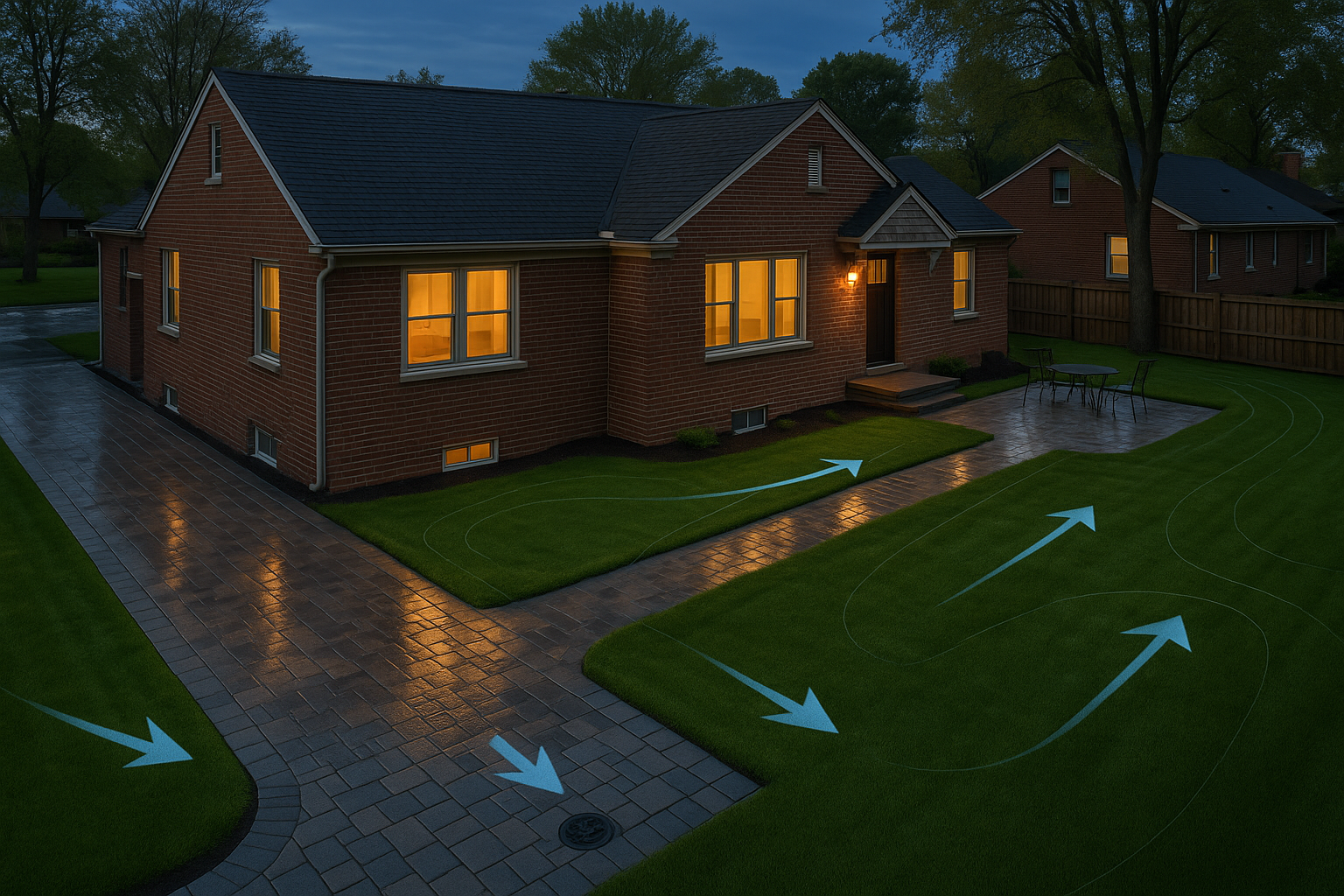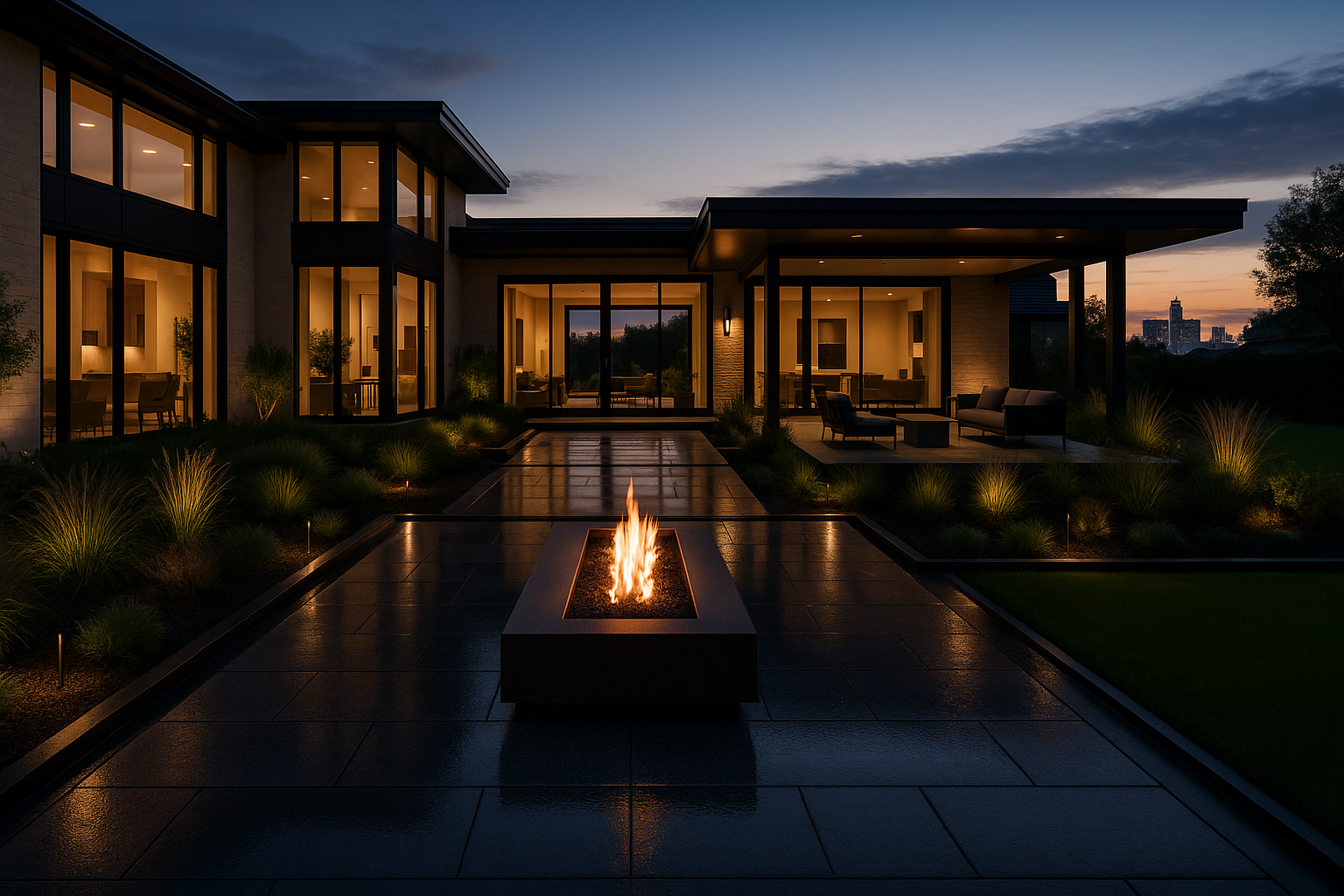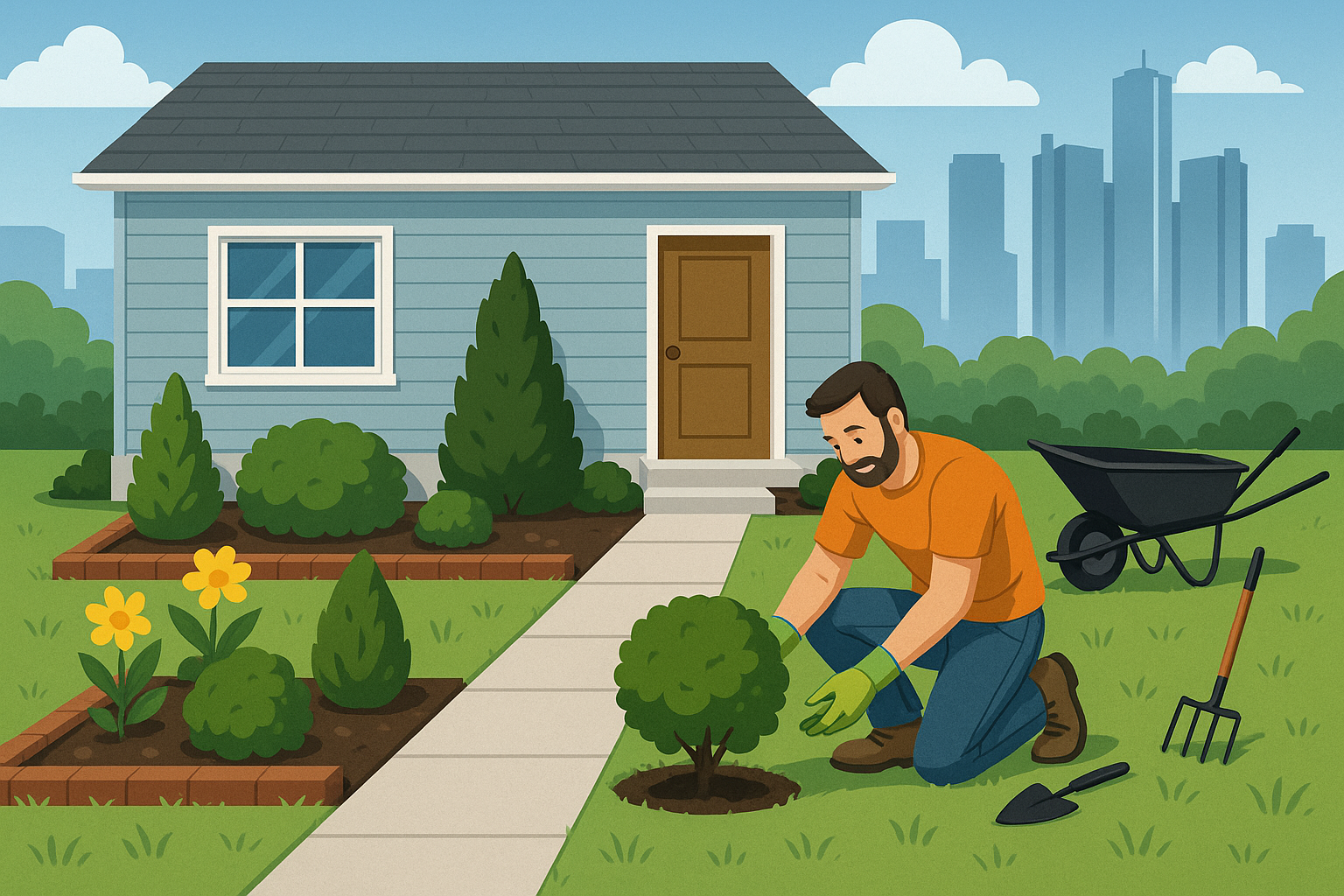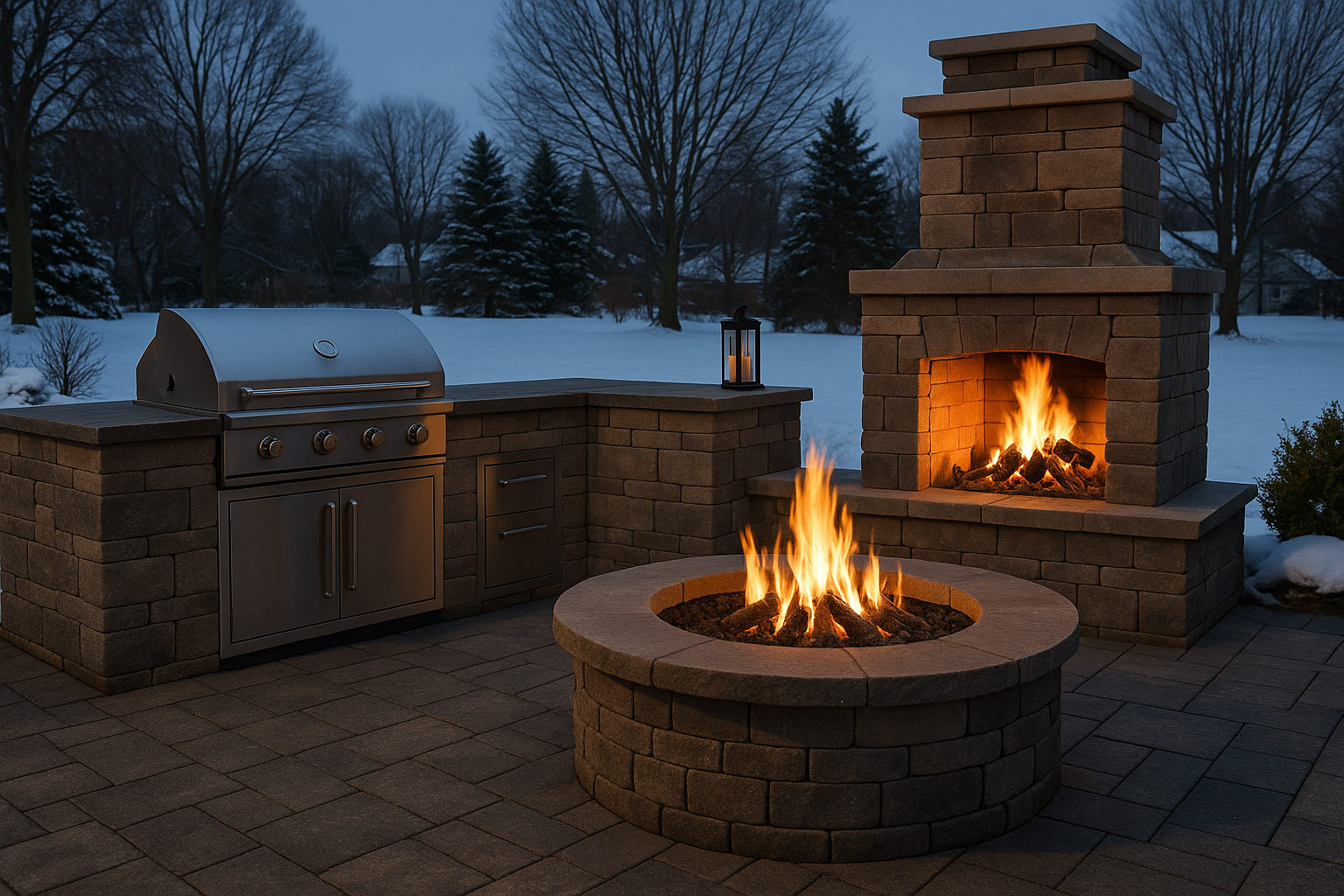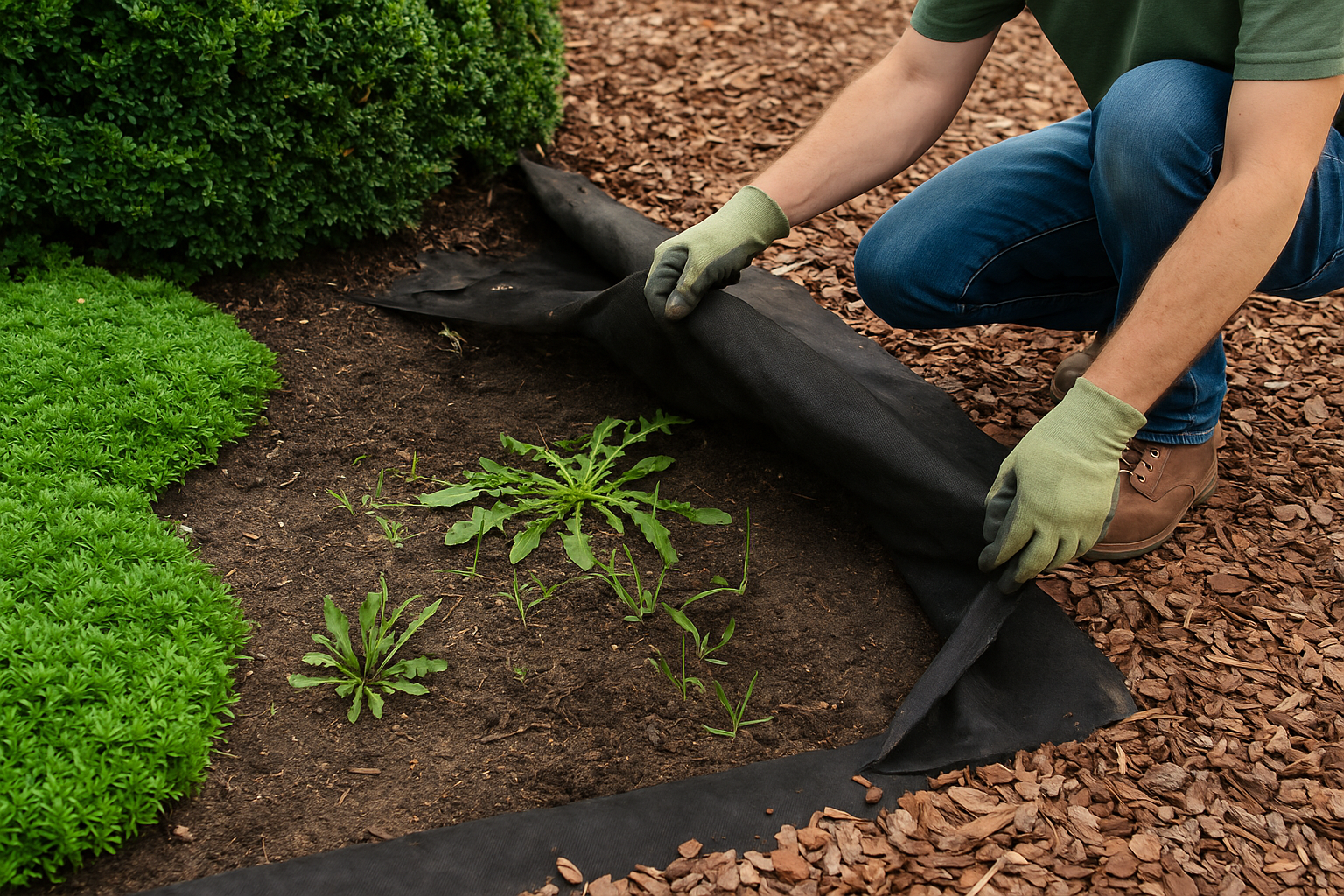Year-Round Appeal & Seasonal Landscaping Strategies
Designing Detroit Yards That Shine Through Every Season
Detroit homeowners know all too well how quickly a traditional lawn can turn into a money pit. One hot summer without rain, and the grass turns brown and brittle. A heavy spring downpour, and you’re wrestling with muddy swales or clogged flower beds. What if your landscape could be both beautiful and virtually self-sustaining—thriving on less water, fewer chemicals, and minimal upkeep? That’s the promise of sustainable, native plant–focused design.
In this guide, you’ll discover how to transform your yard into a resilient oasis that celebrates Michigan’s unique climate. You’ll learn why native species outperform imports in Southeast Michigan, which showstoppers deliver season-long curb appeal, and how to weave pollinator pathways through your garden. Along the way, you’ll see how thoughtfully paired stone walkways and discreet LED landscape lighting elevate your space to high-end status—all while slashing water bills and chemical use. Trust in a seasoned Michigan landscape company to guide you through every step of landscape installation, turning your yard into a low-impact haven that neighbors envy and wildlife adore.
Designing with Detroit’s Native Palette
Why Native Plants Outperform Imports in Zones 5–6
Foundation plants must survive Michigan’s heavy clay soils and brutal freeze–thaw cycles—conditions that can crush imported loamy or sandy-soil species. Native perennials, however, evolved alongside our local weather extremes. Species like Black-eyed Susan (Rudbeckia hirta) and Purple Coneflower (Echinacea purpurea) send roots deep into the earth, tapping moisture and nutrients beyond the reach of shallow turf grasses. Those broad, fibrous roots also help break up compacted clay, improving soil structure over time.
In contrast, many non-native ornamentals struggle to establish in our sticky, waterlogged ground come spring or resist drought in midsummer. By choosing species adapted to Detroit landscaping realities, you dramatically reduce plant loss, lower irrigation needs, and avoid costly re-planting. A professional landscape company knows which cultivars thrive here—saving you headaches and out-of-pocket expenses down the road.
Top Showstoppers for Instant Curb Appeal
Want year-round color without constant attention? These six Michigan natives are guaranteed crowd-pleasers:
- Michigan Lily (Lilium michiganense): Striking orange blossoms light up shaded beds in mid-summer.
- Little Bluestem Grass (Schizachyrium scoparium): Offers fine, steel-blue foliage that turns coppery in autumn.
- Bee Balm (Monarda didyma): Magenta flower clusters attract hummingbirds and bees from July through September.
- Blanketflower (Gaillardia aristata): Vibrant red-and-yellow blooms persist from late spring to frost.
- Black-eyed Susan (Rudbeckia hirta): Sun-loving, easy to propagate, and excellent for mass plantings.
- Purple Coneflower (Echinacea purpurea): Architectural seedheads provide winter interest and bird food.
These perennials follow staggered bloom schedules—spring bulbs give way to early summer coneflowers, then late-summer bee balm and blanketflower. Scatter them among stone walkways or frame a custom patio for a landscape that feels meticulously curated, yet demands little beyond a seasonal cut-back.
Pollinator Pathways & Micro-Prairies
Transform your garden into a living corridor for bees, butterflies, and birds. Rather than isolated flower beds, consider:
- Meadow Strips: Replacing narrow lawn strips with mixed grasses and wildflowers creates both habitat and a naturalistic aesthetic.
- Layered Beds: Group plants by height—tall coneflowers in back, medium-height bee balm in the middle, and low-growing groundcovers like
sedum or
thyme in front.
- Continuous Blooms: Select species whose flowering times overlap to ensure nectar sources from spring through fall.
By integrating pollinator pathways, you reduce the need for chemical pest controls—beneficial insects naturally keep harmful populations in check. According to the Michigan Pollinator Initiative, native plantings can increase pollinator visits by up to 75% compared to traditional lawns (source). A thoughtfully designed backyard transformation not only pleases the eye but also contributes to regional biodiversity.
Luxury Looks with Low Input
Eco-friendly yards don’t have to look rustic. Pair native plant swaths with high-end hardscape touches:
- Custom Patios: Use natural stone or permeable pavers to create seating areas that handle Detroit’s rainfall without pooling.
- LED Landscape Lighting: Discreet path lights, uplights, and well lights highlight textures of native grasses and flower clusters after dark.
- Boulder Accents: Large stones placed strategically along beds or near seating areas add sculptural interest and reduce edging maintenance.
Rohto Landscaping’s landscape lighting company services ensure fixtures blend seamlessly into the landscape, providing safety and ambiance while respecting the ecosystem. These luxury elements elevate a low-maintenance yard to resort-quality grounds.
Eco-ROI: Lower Water Bills & Fewer Chemicals
A Detroit-area homeowner partnered with a local landscaping companies detroit report cut annual mowing, watering, and chemical costs by 50% after converting half their lawn to native meadow planting. Traditional turf requires weekly mowing, up to 30 inches of water per year, and multiple fertilizer applications. In contrast, native meadows and pollinator beds thrive on natural rainfall and require only a late-season mow or burn to reset the cycle.
Fewer fertilizer applications mean reduced runoff into local waterways, protecting Lake St. Clair and the Detroit River from nutrient overload. Over time, these savings and environmental benefits more than justify the initial landscape installation investment. In essence, you’re paying once to install, then reaping financial—and ecological—rewards year after year.
Permeable Pavers 101
Why Permeable Pavers Outshine Asphalt
Traditional asphalt or concrete driveways and patios shed water rapidly, sending torrents of runoff toward your basement, lawn, or the street. In contrast, paver driveways and brick paver patios set with permeable joints allow rain to filter through the surface, reducing puddles and recharging groundwater. Key advantages include:
- Reduced Flooding Risk: Up to 80% of rainfall can infiltrate through permeable pavers, compared to near-zero infiltration on impervious surfaces (source: U.S. EPA).
- Eco-Friendly Aesthetics: A wide array of stone colors and patterns lets you match your home’s style while embracing green infrastructure.
- Heat Reduction: Unlike asphalt, pavers do not trap heat, helping moderate surface temperatures on hot Detroit days.
Best Practices for Design & Maintenance
Achieving reliable drainage requires more than simply choosing permeable blocks. Follow these guidelines for a long-lasting installation:
- Proper Excavation Depth: Remove native soil to a depth of at least 8–12 inches, depending on expected traffic loads.
- Layered Base System: Install successive lifts of angular aggregate—each compacted—so water flows freely downward while offering structural support.
- Geotextile Fabric: Lay a permeable membrane to separate subgrade from your gravel base, preventing soil from clogging voids.
- Joint Materials: Use polymeric sand or engineered gravel that resists wash-out yet allows water passage.
- Routine Sweeping: Clear debris from paver joints seasonally to prevent sediment build-up.
- Periodic Power Rinsing: A gentle rinse every 2–3 years restores infiltration rates without disturbing base layers.
By following these landscape installation standards, you ensure your patio or driveway not only looks pristine but performs reliably through Detroit’s heavy spring showers.
Rain Gardens & Bioswales for Midwest Downpours
Site Selection & Soil Preparation
Rain gardens and bioswales act as natural detention basins, capturing roof and surface runoff before it inundates lawns or local storm sewers. To siting one effectively:
- Locate Downslope of Runoff Sources: Position rain gardens 5–15 feet from a roof downspout or low-lying lawn area.
- Test Soil Infiltration: A simple percolation test—dig a 12-inch hole, fill with water, and measure how quickly it drains—helps determine if you need amended soils.
- Amend Soil Mix: Where clay is dominant (common in Detroit), blend native soil with compost and sharp sand (at least 50% organic content) to achieve 1–2 inches per hour infiltration.
Plant Palette & Layering
A successful rain garden combines structural stability with seasonal interest:
- Deep-Rooted Grasses: Switchgrass and little bluestem anchor the mix and draw water deep into the profile.
- Moisture-Loving Perennials: Obedient plant varieties such as blue flag iris, swamp milkweed, and Joe-Pye weed handle periodic flooding effortlessly.
- Edging Plants: Native sedges or dwarf fountain grass soften borders and reduce soil erosion along swale edges.
Careful layering—from coarse gravel at the bottom, to amended soil in the middle, to organic mulch on top—ensures both performance and a polished appearance.
Benefits Beyond Flood Control
- Improved Water Quality: Plants and soil microbes filter pollutants like nitrates, phosphorus, and petroleum residues before they infiltrate groundwater.
- Wildlife Habitat: Rain gardens become micro-ecosystems that attract pollinators, songbirds, and beneficial insects.
- Neighborhood Resilience: When every home incorporates stormwater landscaping—from
landscape companies detroit to DIY projects—street flooding and sewer overflows decrease community-wide.
Transforming Low Spots into Functional Oasis
From Boggy Depressions to Garden Rooms
Low spots in your yard don’t have to be an eyesore. With the right deck and patio design, you can convert those soggy hollows into inviting gathering nooks:
- Re-Grading & Drainage Anchors: Slightly slope the surrounding terrain toward discreet inlets that feed rain gardens or underground drains.
- Raised Planter Edges: Build stone or brick planter walls—echoing your patio materials—to contain high-ground beds that frame the space.
- Stepped Hardscapes: Use custom patios with tiered levels that adapt to slope variations, creating terraced enclave areas for seating or fire pits.
Balancing Hard and Softscapes
Integration is key. Consider these design tips:
- Contrast Textures: Pair smooth bluestone pavers with rough-hewn boulder seats for tactile appeal.
- Soft Plant Buffers: Line pathways with tall native grasses to provide privacy and soften stone edges.
- Overhead Structures: Pergolas or retractable canopies offer shade and emphasize the transition from house to landscape.
A harmonious balance of hardscape design and garden landscaping not only looks sophisticated but solves functional challenges—turning seasonal low spots into signature features.
Lighting & Tech for Eco-Friendly Ambiance
Solar & Low-Voltage Lighting Solutions
Extending usability into evening hours requires thoughtful illumination. Technologies to consider include:
- Solar-Powered Path Lights: Easy to install, zero energy costs, and minimal maintenance. Perfect for marking
permeable paver walkways.
- Low-Voltage LED Fixtures: Run by dedicated transformers, these lights offer brighter output and longer life spans with negligible energy draw.
- Smart Controls: App-enabled timers and motion sensors ensure lighting activates only when needed—enhancing security and saving power.
A professional landscape lighting company near me can design circuits that showcase focal points (a rain garden, water feature, or specimen tree) while avoiding light pollution.
Weather-Adaptive Irrigation Tech
Automated systems now match watering to actual conditions:
- Rain Sensors: Prevent sprinklers from running during or after precipitation.
- Soil Moisture Probes: Monitor root-zone humidity in real time, triggering precise drip or spray events only when necessary.
- Smart Controllers: Integrate local weather forecasts to adjust schedules automatically, reducing water waste by up to 40% (EPA).
When paired with landscape company services that include regular maintenance checks, these technologies make water-wise landscapes virtually self-sustaining.
Permitting & Local Ordinances
Navigating Detroit’s Stormwater Credits
Many Michigan municipalities offer incentives—such as reduced stormwater fees or tax breaks—for homeowners who install approved green infrastructure. A qualified Michigan landscape company can:
- Submit design plans to local authorities.
- Calculate expected runoff reduction to qualify for credits.
- Ensure ongoing compliance through annual reporting.
Grading, Drainage, & HOA Guidelines
- Right-of-Way & Drainage Easements: Understanding your property’s flow paths prevents legal disputes with neighbors.
- HOA Aesthetics Rules: Some communities have strict guidelines on paver colors, fencing heights, or planting lists.
- Permit Handling: From excavation permits to electrical permits for lighting, Rohto Landscaping’s
landscape construction company expertise ensures your project moves smoothly from blueprint to build.
By integrating water-smart hardscapes, rain gardens, and modern tech, you create a resilient, low-maintenance landscape perfectly suited to Detroit’s climate. These measures protect your home, enhance curb appeal, and contribute to a healthier urban watershed. Ready to harness the power of stormwater solutions? Explore Rohto Landscaping’s full suite of eco-friendly services and start your transformation today.
Seasonal Care Calendar for Native & Hybrid Yards
Spring: Revival and Inspection
After a long Michigan winter, your landscape needs careful attention to awaken dormant plants and prepare soils:
- Cut Back Dead Growth: Remove last year’s seed heads and stalks from native perennials such as Black-eyed Susans and Purple Coneflowers. Cleaning up prevents disease and allows new shoots to emerge unimpeded.
- Mulch Refresh: Apply a 2- to 3-inch layer of organic mulch around beds to suppress early weeds, retain moisture, and regulate soil temperature. Be sure to pull mulch slightly away from plant crowns to avoid rot.
- Winter Damage Assessment: Look for heaved plants, broken branches on shrubs, and areas where snowmelt has pooled. Address soil compaction with light aeration in small lawn patches.
Summer: Maintenance and Monitoring
During Detroit’s humid summers, the focus shifts to keeping both hardscape and softscape thriving under heat and sun:
- Light Weeding & Mulching: Tackle weeds promptly before they set seed, and top up mulch as needed to maintain consistent coverage.
- Moisture Monitoring: Even drought-tolerant natives benefit from supplemental water during prolonged dry spells. Use a soil probe or moisture sensor to check root-zone humidity before activating sprinklers or drip systems.
- Pest & Disease Watch: Scan leaves and stems for early signs of fungal infections or insect damage. Many issues can be managed organically if caught in time—such as spraying with horticultural oils or introducing beneficial insects.
Fall: Preparation & Transition
Fall is critical for setting the stage for winter resilience and spring vigor:
- Leaf Removal & Composting: Rake fallen leaves from lawn areas to prevent smothering turf and then compost or shred them into mulch.
- Winter-Prep Fertilization: Apply a slow-release, balanced fertilizer to bolster root health during dormancy. This is especially beneficial in heavy
clay soils common in Detroit.
- Strategic Pruning: Trim deadwood from shrubs and small trees, and cut back perennials to a few inches above ground (unless you’re leaving seedheads for winter interest).
Winter: Protection & Early Checks
Even as the ground freezes, your landscape requires minimal but essential care:
- Root Zone Insulation: Add an extra inch of mulch around vulnerable perennials and newly planted shrubs to reduce freeze-thaw damage.
- Snow Management: Clear heavy snow from delicate shrubs and evergreen branches to prevent breakage. Avoid piling snow on garden beds that contain bulbs or low plantings.
- Erosion & Drainage Checks: During thaw cycles, inspect areas around patios and swales for new washouts or pooling water that could indicate drainage issues to address come spring.
Smart Irrigation & Soil Health
Precision Watering with Drip & Sensor Technology
Overwatering is almost as damaging as drought, especially in clay-rich Detroit soils that hold water and suffocate roots. Implementing targeted irrigation solutions ensures plants receive just the right amount:
- Drip Irrigation for Beds: Custom-designed drip lines deliver moisture directly to root zones of garden beds and native plantings, cutting evaporation by up to 70% compared to overhead sprinklers (source: University of Minnesota Extension).
- Smart Controllers & Rain Sensors: A
landscape lighting company near me can integrate weather-adjusting controllers that halt irrigation during rain events, conserving water and preventing oversaturation.
- Moisture Sensors: Place sensors at varying depths (2–6 inches) to gauge real-time soil moisture. This data-driven approach eliminates guesswork and protects both drought-tolerant natives and supplemental plantings.
Annual Soil Tests & Topdressing
Healthy soil underpins every thriving landscape. A yearly soil analysis identifies nutrient imbalances and pH issues so you can tailor amendments precisely:
- Soil Sampling: A
Michigan landscape company can collect and test soil every fall, recommending organic compost, lime, or sulfur to adjust conditions.
- Topdressing for Turf & Beds: Lightly spread compost or specialized topsoil blends over lawns and planting areas to build organic matter. This practice improves drainage in heavy clay and supports microbial life vital for plant health.
Monitoring Hardscapes After Freeze-Thaw Cycles
Detroit’s seasonal temperature swings put patios, driveways, and walkways to the test. Routine inspections ensure longevity and prevent costly repairs:
- Visual Surveys: Each spring, scan paver driveways and
brick paver patios for settling, shifting joints, or cracks. Early detection allows for simple joint sand replacement or minor leveling rather than full repaving.
- Joint Sand & Edge Restraints: Reapply polymeric joint sand where erosion is evident. Check edge restraints for movement; secure or replace to maintain a solid perimeter.
- Base Repairs: In areas of repeated heaving, remove a few pavers, repack the gravel base, and reinstall. Proper
landscape installation techniques keep surfaces flat and water-free.
Rohto Landscaping’s routine hardscape maintenance packages cover these tasks, ensuring your patios and walkways complement the surrounding native plantings without interruption.
Upgrades Over Time: Backyard Transformation
A sustainable landscape evolves. As needs and tastes change, phased enhancements help you continuously refresh your outdoor space without overhauling existing ecosystems:
- Pergolas & Shade Structures: Introduce overhead elements that provide sun relief while supporting climbing vines such as native
Virginia creeper or
clematis.
- Outdoor Kitchens & Fire Features: Add a modular grill station or pizza oven adjacent to your permeable paver patio. Incorporate a fire pit or fireplace built with local stone to anchor gathering spots.
- Poolside Landscaping: Frame a swimming area with drought-tolerant grasses and minimal-maintenance perennials. Use natural
stone and brick masonry to create pathways that link pool decks to terraces.
- Water Features & Wildlife Habitats: Install a small recirculating pond or fountain populated with native aquatic plants. These additions boost ambiance and attract birds, frogs, and beneficial insects.
By phasing in upgrades—rather than all at once—you spread costs over time and allow each new element to integrate seamlessly with your established sustainable framework.
Why Professional Stewardship Matters
A thriving, sustainable landscape demands expertise and ongoing care—qualities only a dedicated Detroit landscaping company can deliver:
- Scheduled Audits & Tune-Ups: Annual site visits to evaluate plant health, soil conditions, drainage performance, and irrigation efficiency.
- Early Problem Detection: Trained eyes spot subtle signs of pest pressure, nutrient deficiencies, or structural concerns before they escalate.
- Customized Service Packages: From monthly garden checks to quarterly hardscape assessments, a full-service provider ensures your yard remains a showpiece.
Rohto Landscaping’s luxury landscape company services combine deep native-plant knowledge with precision hardscape installation and cutting-edge irrigation technology. This commitment to stewardship keeps landscapes vibrant, functional, and low-impact for the long haul.
Cultivating Lasting Value: Your Yard, Your Legacy
Over the course of this guide, you’ve explored:
- Seasonal care routines that align with Michigan’s climate extremes.
- Smart watering strategies that save resources and protect plantings.
- Hardscape monitoring essential for preserving patios and paver walkways amid freeze-thaw cycles.
- Gradual upgrades that transform low spots, add shade structures, and introduce modern amenities.
- Professional stewardship as the backbone of ongoing landscape success.
Each element weaves into a cohesive approach that makes your yard not just beautiful, but resilient—an asset for you, your family, and the broader Detroit ecosystem.
Invest in Your Outdoor Oasis Today
Experience the difference that expert design, installation, and maintenance can make. Whether you’re starting fresh or enhancing an established garden, Rohto Landscaping delivers greater landscapes tailored to Detroit’s unique conditions. Explore our full range of services or reach out for a personalized consultation. Let’s create a sustainable, luxurious outdoor environment you’ll enjoy for decades to come.

